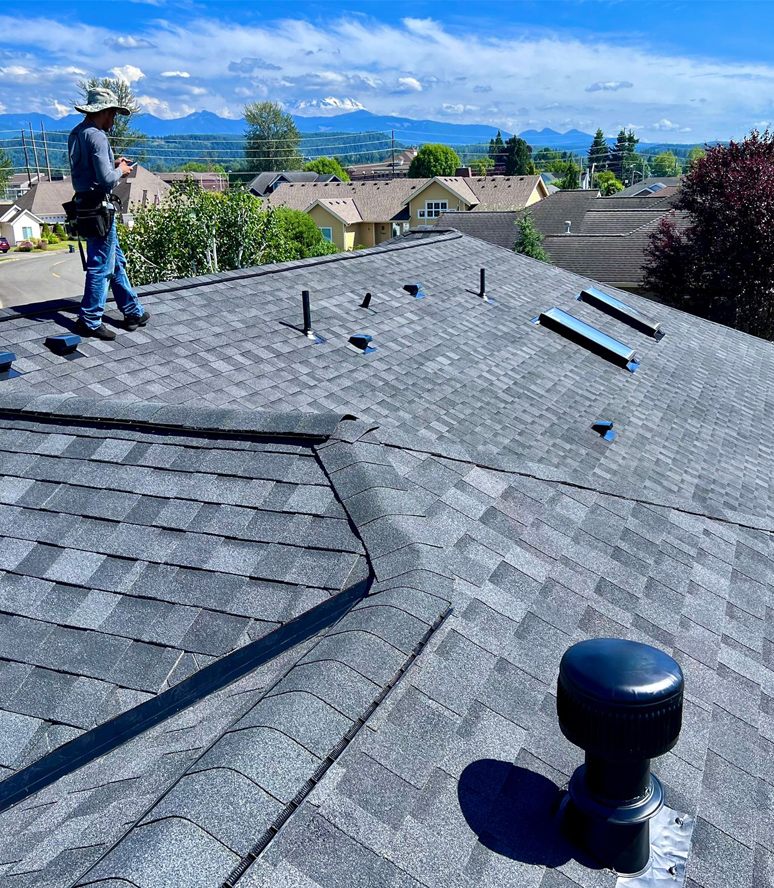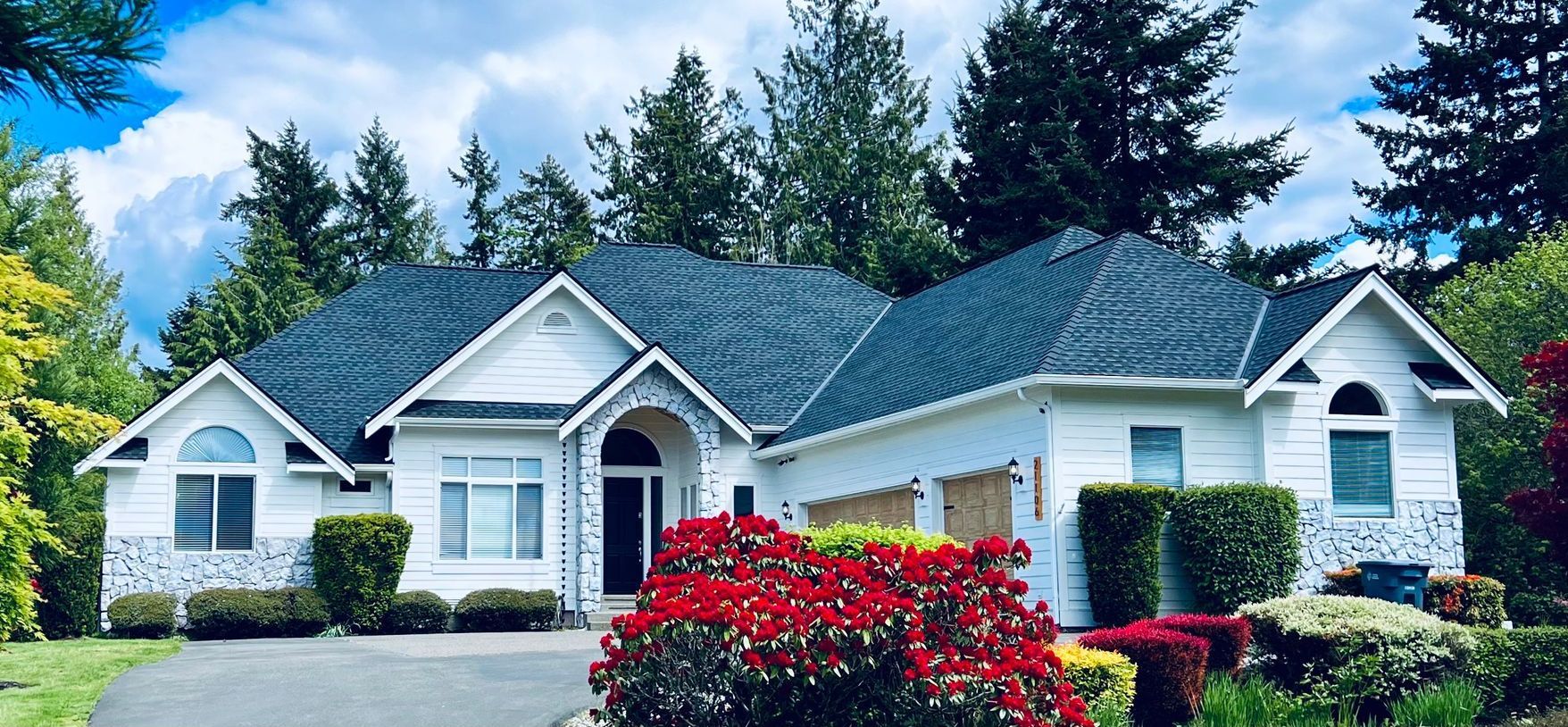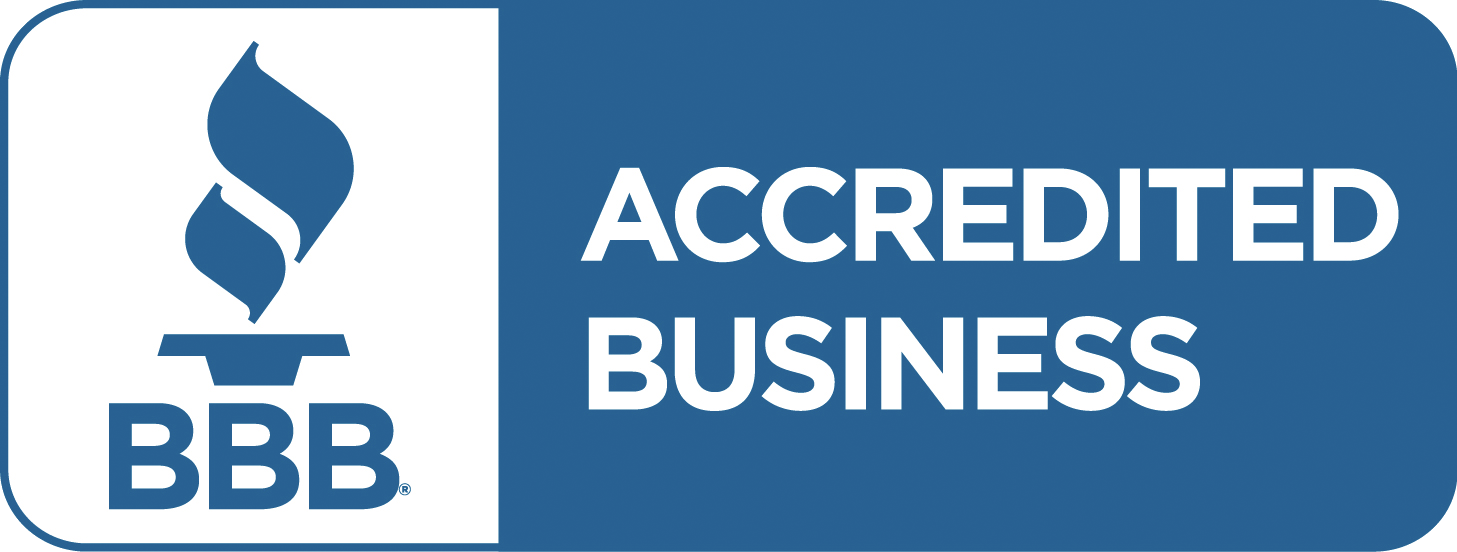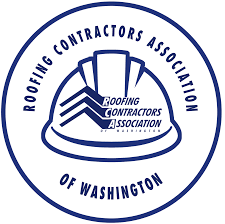Quality, Professional Residential Roof Repairs

Roof Repairs
Skye Exteriors offers reliable and professional residential roof repair services to homeowners who must address roof issues. Whether it's a leak, damage from storms, or general wear and tear, our team of experts are dedicated to providing high-quality solutions to keep your home safe and protected. At Skye Exteriors we take pride in attention to detail and use of top-quality materials to ensure that every repair job is done right the first time. We are committed to delivering exceptional customer service and making the repair process as stress-free as possible for our clients.
Skye Exteriors prides itself on its attention to detail and excellent customer service, ensuring that every homeowner is completely satisfied with the final result.
Roof Repairs: How to Fix Leaks and Damage
Identifying roof leaks and damages often start from within your home. Water stains on your ceiling, damp spots, or peeling paint are tell-tale signs that point towards a leaky roof, demanding immediate attention. However, the decision between repairing these issues or opting for a complete replacement isn't always clear-cut. A comprehensive understanding of the present condition of your roof along with notable features like its age and the extent of damage involved can determine the best course of action- to repair or replace. Now, one particular place to begin your search might be right over your head.
Scheduling a roof repair service with Skye Exteriors is simple. You can contact our dedicated team at 360-226-3397 to discuss your repair needs and schedule an inspection at your convenience. Our experienced roofing professionals will then assess the damage, provide a detailed estimate, and efficiently carry out the necessary repairs to restore the integrity of your roof.
Identifying Roof Leaks and Damages
The roof is a vital part of our homes, offering protection from the elements. However, it's susceptible to harsh weather conditions, wear, and tear, which can result in issues such as leaks and damage. This section focuses on the key areas you need to check to identify roof leaks and damages before they worsen.
Check for Interior Leaks
During rainfall, water stains on your ceiling or walls, damp spots, or peeling paint may become evident - clear indications of a potential roof leak. It's important not to overlook these signs as they could signal a more substantial issue with your roofing.
Sometimes, leaks aren't immediately obvious and might only become apparent after heavy rainfall. Keep an eye out for any unexplained changes in your home's interior, like musty odors or dampness in the air. While it's easy to dismiss these as regular indoor humidity concerns, they could be connected to unnoticed roof leaks.
Exterior Inspection
Visually inspecting the roof exterior can reveal a lot about its current condition. Look for missing, cracked, or damaged shingles as well as any areas with moss or mold growth - common signs of water penetration that could point to areas needing repair.
Inspecting the exterior might require using a ladder to get an up-close view of the roof surface. Ensure safety measures are in place before attempting any climb. If climbing up seems dangerous or you're uncomfortable with heights, it might be best to call in a professional roofer who's well-equipped and experienced in such inspections.
Attic Examination
Head up to the attic for a thorough examination. Check for signs of water damage such as wet insulation, mold growth, or even sunlight shining through the roof boards. If you notice sunlight coming through, this indicates gaps or holes in the roofing that need immediate attention.
Mold growth in the attic is often an indicator of moisture buildup—especially concerning if left unaddressed; it can lead to structural issues and pose health risks for occupants due to poor air quality. Wet insulation is another red flag that shouldn't be ignored as it may compromise its effectiveness and further contribute to energy loss.
By being proactive in identifying these potential issues with your roof, it becomes easier to address them before they grow into larger problems requiring extensive repairs. A regular inspection routine and swift action when needed can significantly extend the lifespan of your roof while maintaining the integrity of your home's structure.
It's crucial to remember that any significant damage or suspected leaks should be addressed by a professional roofing contractor. Trying to fix these issues yourself could lead to safety hazards and potentially worsen the existing problem.
As we shift our focus from identifying roof issues to discussing various materials suitable for protecting your home from above, let's explore the different types of roof materials and their unique attributes.
Common Types of Roof Materials
Imagine your roof as a shield, protecting everything you hold dear from the elements. But what makes this sturdy shield? The type of material it’s made of! Each roofing material has its own character, strengths, and weaknesses. Let's take a closer look at the most common types:
Asphalt Shingles
Asphalt shingles are one of the most popular roofing materials, mainly due to their affordability and ease of installation. They come in a variety of colors and styles, offering versatility in design. However, they do have a relatively shorter lifespan compared to other materials and may require regular maintenance to ensure longevity.
Metal Roofing
Metal roofs are known for their exceptional durability and longevity, with some metal roofs lasting 50 years or more. They are resistant to fire, mildew, insects, and rot, making them a low-maintenance option for homeowners. Additionally, metal roofs are eco-friendly and energy-efficient, reflecting solar radiant heat to keep homes cooler in hot climates.
Tile Roofing
Tile roofing provides a distinct, elegant aesthetic appeal and exceptional durability. With proper maintenance, tile roofs can last over 100 years. They offer excellent resistance to fire, rot, insects, and harsh weather conditions. However, it's important to note that tile roofing is heavier than other materials and may require additional structural support.
Wood Shakes
Wood shakes provide a natural and rustic look while offering good insulation properties. They are typically made from cedar, redwood, or pine and can last up to 30 years with regular maintenance. However, wood shakes may be susceptible to rot, mold, and insect damage if not properly cared for.
Each roofing material presents its own benefits and considerations based on factors such as climate, architectural style, budget, and desired lifespan. When selecting the right material for your roof, it's crucial to consider your specific needs alongside the unique characteristics of each material.
Understanding the distinct features of different roofing materials is essential for making informed decisions when it comes to maintaining or replacing your roof. Let's now explore how these various materials influence maintenance requirements and how to effectively care for each type.
Repairing Shingles, Tiles, and Metal Roofs
When it comes to taking care of your roof, different materials might require distinct repair approaches. Let's break down what you need to know about fixing shingles, tiles, and metal roofs. We'll start with asphalt shingles, one of the most popular choices for residential roofing due to their affordability and durability.
Shingle Repairs
Asphalt shingles can crack, curl, or become displaced over time due to exposure to the elements. To address damaged asphalt shingles, you'll need roofing cement to seal any cracks or crevices. Here's a quick guide to help you along:
- Repairing Cracks: Clean off any debris from the cracked area, apply roofing cement underneath the crack, then press the shingle down to secure it in place.
- Handling Curled Shingles: Apply roofing cement below the curled section and press it down firmly. Utilize nails as necessary to keep the shingle in place while the cement sets.
- Replacing Missing Shingles: When a shingle is missing, use roofing cement to attach a new one securely.
Addressing damaged shingles promptly can help prevent leaks and further damage to your roof structure.
Now let's move on to tile roofs. These roofs are known for their longevity and aesthetically pleasing appearance.
Estimation: Cost of Roof Repairs
Roof repairs entail more than just fixing shingles or tiles; the financial aspect is equally crucial. The cost of roof repairs can vary widely based on key factors, including the extent of the damage, the type of materials involved, and the labor required. This understanding is vital for making informed decisions about roof maintenance.
Minor repairs generally range from $150 to $400, with costs varying based on location and specific circumstances. For instance, a straightforward repair such as replacing a few missing or damaged shingles may be on the lower end of the spectrum. Conversely, extensive damages or structural issues requiring significant labor and materials can escalate costs into several thousand dollars.
Consider this scenario: A small roof leak stemming from damaged flashing may only require minor repairs and fall on the cheaper end of the spectrum. However, a larger leak causing water damage to the underlying structure will entail more extensive repairs and incur higher costs.
Homeowners should consider these potential costs when budgeting for roof maintenance. Neglecting necessary repairs due to expense concerns can lead to greater costs in the long run if minor issues escalate into major structural problems.
Seeking professional assessment and estimates for roof repairs is crucial for gaining a clear understanding of anticipated costs. Reputable roofing contractors can provide detailed quotes outlining all aspects of the repair work and associated expenses.
Understanding the varying costs associated with roof repairs allows homeowners to make proactive decisions about maintaining their roofs and addressing potential issues before they escalate into more significant financial burdens.
Now equipped with an understanding of roof repair costs, let's explore do-it-yourself tips for basic roof repairs.
Do-It-Yourself Tips for Basic Roof Repairs
Taking on roof repairs yourself can save you money, but it comes with its own set of risks. It's important to approach the task with caution and ensure you have the right safety equipment before getting started. Your personal safety should always be your top priority when working on any DIY project, especially one that involves heights and potential hazards like a damaged roof.
Safety First
Before you set foot on your roof, make sure you have proper safety equipment on hand. This includes wearing non-slip shoes to prevent falls, a secure harness to keep you tethered to the structure, and sturdy gloves to protect your hands from sharp edges or nails.
A fall from an elevated surface such as a roof can cause serious injury, so it's crucial to take every precaution to safeguard yourself. While the allure of DIY projects is often the satisfaction of completing them on your own, there are times when it's worth considering hiring a professional to avoid potential accidents or harm.
The next step in your DIY journey is to prepare the surface before beginning any repairs.
Clear Debris
When it comes to basic roof repairs, it’s essential to create a safe and stable working environment. Before diving into any repairs, take the time to clear debris from the roof surface. Remove leaves, branches, or any other loose material that could pose a hazard as you work. This will not only minimize potential accidents but also provide a clean work area where you can move around safely.
By taking these initial steps to ensure safety and prepare the working environment for repairs, you're ready to consider the fundamental decision of whether it’s best to repair your existing roof or opt for a full replacement.
Deciding Between Roof Repairs vs. Roof Replacement
Your roof is a crucial part of your home—it protects you from all kinds of weather and keeps you safe and dry. But over time, it may need some extra attention to continue doing its job effectively. This brings up the question: Should you repair the damage or replace the whole thing? It's a big decision, so let's break down some important factors to consider.
Consider Age and Condition
One of the first things to think about when deciding between a repair and a replacement is the age of your roof. If your roof is relatively new, with only isolated areas of damage, repairing those specific areas might be enough to maintain its integrity. However, if your roof is approaching the end of its expected lifespan or has extensive damage, it might be more cost-effective in the long run to opt for a full replacement.
Another aspect to consider is the type of damage: Is it localized or spread out across the entire roof? If it's just one or two shingles that are damaged, a repair may suffice. But if there are widespread issues like multiple leaks or significant wear and tear, a replacement might be necessary.
Cost Evaluation
It's natural to think about costs when making this decision. The price tag for roof repairs may seem lower upfront compared to a full replacement. However, it's essential to factor in long-term benefits and the remaining lifespan of your current roof. For example, if your roof is nearing the end of its lifespan and you foresee future costly repairs down the road, investing in a replacement now could save you money in the long term.
Let's say your roof has extensive damage due to a storm. While repairing the visible damage may seem like an immediate solution, it's vital to consider potential underlying issues that could lead to more significant problems in the future. In this case, consulting with a professional roofer can provide insights on whether a repair will adequately address all the issues or if a replacement is the more prudent choice.
Consult a Professional
When you're unsure about which route to take, seeking guidance from a professional roofing contractor is invaluable. They can conduct a thorough assessment of your roof's condition and provide expert advice on whether repairs are suitable or if a complete replacement is necessary.
A skilled roofer will take into account various factors such as the extent of damage, the age of your roof, any previous repairs, and potential long-term implications. Their expertise can help you make an informed decision that aligns with your needs and budget while ensuring the safety and longevity of your home's roofing system.
By carefully considering these factors and seeking professional guidance, you can confidently decide whether repairs or replacement is the best course of action for your roof. Making this decision thoughtfully can contribute to maintaining the structural integrity and longevity of your home's roofing system while maximizing cost-efficiency in the long run.
When it comes to safeguarding your home and making critical decisions about its maintenance, trust Skye Exteriors LLC for reliable roofing services tailored to your needs.



